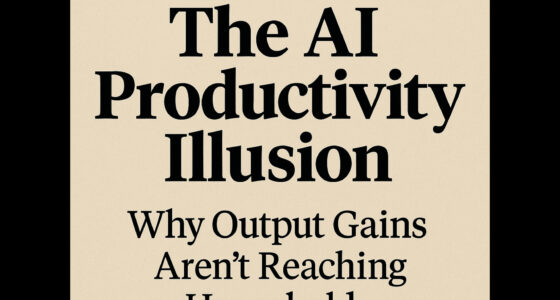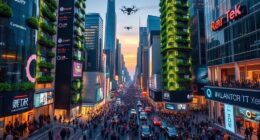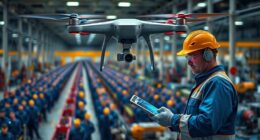In today’s automated economy, most robots are owned by large corporations and nation-states, who control industrial and personal automation tools. Investment concentration and technological advances favor big players, widening wealth gaps. Smaller firms and individuals face barriers to ownership due to high costs and capital requirements. As automation evolves, ownership models are shifting toward digital assets and decentralization, shaping future economic power dynamics. To understand how these changes affect you, keep exploring more details.
Key Takeaways
- Large corporations and multinationals currently dominate ownership of industrial and service robots due to high capital requirements.
- Wealth concentration is increasing as automation benefits those with substantial capital investments, widening economic inequality.
- Technological advances and low-code platforms enable greater user autonomy, potentially decentralizing ownership models.
- Regional disparities exist, with Asia Pacific leading growth and ownership concentrated among big firms in developed nations.
- Policy and infrastructure investments influence ownership patterns, favoring domestic automation sectors and strategic autonomy.
The Rise of Domestic and Personal Robots

Have you noticed how domestic and personal robots are transforming everyday life? The global household robots market was valued at around USD 12 billion in 2024 and is projected to surpass USD 81 billion by 2035, growing at nearly 19% annually. In the U.S., the market hit USD 7.11 billion in 2023, with expected growth of about 8.3%. Personal service robots, which handle chores like cleaning and cooking, are expected to reach USD 14.7 billion by 2025. Meanwhile, the market for personal assistance robots is set to nearly double from USD 3.9 billion in 2025 to USD 7.7 billion by 2030. These robots, equipped with AI and sensors, are making household routines more efficient and accessible, reshaping how we live. Market growth projections also indicate a significant shift towards automation, with the household robots segment dominating the industry landscape.
The Industrial Robotics Boom and Market Growth

The rapid growth of domestic and personal robots highlights a broader trend toward automation across various sectors, with industrial robotics leading the charge in manufacturing and production. In 2024, the market was valued at USD 17.78 billion, and projections show a CAGR of over 13.3% from 2025 to 2034. Early 2025 saw the global market for industrial robot installations reach USD 16.5 billion, with estimates placing market revenue at USD 38.45 billion in 2025—set to soar to USD 95.08 billion by 2032 and over USD 235 billion by 2033. Driven by rising labor costs, advanced AI, and demand for faster, higher-quality output, industries like automotive, electronics, and food processing are expanding their use of robotics, fueling this explosive growth. According to recent industry forecasts, the adoption of robotics is becoming a key factor in enhancing industrial productivity, and maintaining competitiveness in global markets, especially as automation technology continues to evolve rapidly, including innovations in Crochet Kits for Beginners and other crafting tools that exemplify how automation influences diverse fields. Additionally, the integration of sustainable manufacturing practices is increasingly influencing the deployment of industrial robots to meet environmental standards and reduce waste. As these trends accelerate, the global robotics market is expected to become a central component of modern industry strategies.
Shifting Ownership Patterns in Automation

As automation ownership shifts from large corporations to smaller firms and individuals, you’ll notice more diverse control over automated systems. Household ownership is growing as low-code platforms make automation accessible to non-experts, changing traditional investment strategies. These evolving patterns influence how automation assets generate value and who benefits most from technological advancements. 60% of companies currently utilize automation tools in workflows, highlighting the widespread adoption and democratization of automation technology across various sectors. Additionally, decentralized control is becoming more prevalent as users gain greater autonomy over their automated systems. Recognizing the importance of soil properties can further optimize the deployment of automation in sectors like agriculture and manufacturing, especially when considering nutrient retention in soil management.
Corporate Ownership Dominance
What factors are driving the shifting ownership patterns in automation? Larger corporations dominate the automation landscape because they have more resources and scale. The automation market is projected to reach $16 billion by 2025, with enterprise companies leading adoption, especially in RPA. These organizations are investing heavily—58% are allocating more resources to technology initiatives—enabling them to implement advanced AI and workflow automation. Currently, over 90% of the automation market revenue comes from on-premises solutions, highlighting corporate dominance. As automation continues to grow, bigger firms benefit from economies of scale, allowing them to integrate sophisticated systems faster. This consolidates ownership within large organizations, reinforcing their control over automation technologies and shaping the future landscape of automated capital. Additionally, the trend towards centralized control further amplifies the dominance of major players in the automation industry.
Household Ownership Growth
Larger corporations currently dominate automation through extensive resources and scale, but household ownership patterns are shifting as consumer interest in personal automation grows. The household robots market is projected to rise from $10.15 billion in 2023 to $48.85 billion by 2032, driven by demand and smart tech integration. As interest increases—especially among younger adults—you’re seeing more households investing in personal robots for chores like cleaning, laundry, and organizing. Cost remains a key factor, with many willing to spend under $1,000. The market is expected to grow at a CAGR of approximately 19.32% through 2034, reflecting increasing adoption and technological advancement. – Consumer interest is rising, with two in five Americans open to owning household robots. – Regional markets expand at different rates, with Asia Pacific leading growth. – Smart integrations and AI advancements make robots more accessible and useful at home, especially as robotic capabilities continue to improve. Additionally, the rapid advancement of AI technology is enabling more sophisticated and adaptable household robots, further accelerating market growth. Furthermore, fostering creative practice in the development of AI-driven robots can lead to more innovative and user-centric designs, enhancing their integration into daily life, especially as Vetted technologies become more reliable and widespread. As the integration of detoxification techniques in health routines increases, similar technological innovations could improve the functionality and appeal of household robots.
Changing Investment Strategies
Technological advancements are transforming investment strategies by making them more automated and data-driven. AI now automates portfolio management, refines risk assessments, and improves asset allocation. As you adapt, you’ll notice that capital investments in AI are booming, reshaping industries and creating new opportunities. This technological overhaul boosts efficiency, with AI tools processing vast data for faster, smarter decisions. Globally, increased power demand from AI fuels innovations in energy sectors. Incorporating natural materials into energy infrastructure can further support sustainable growth. Additionally, understanding Gold IRA Rollovers can provide valuable diversification options for future-proofing your investments. Recognizing the importance of Tableware in cultural and social contexts can also influence market trends and consumer preferences in related industries. Exploring sustainable energy sources is becoming increasingly crucial as the demand for AI-driven energy solutions continues to grow, prompting a shift towards renewable resources that support long-term sustainability.
Economic Impacts of Robotic Capital Concentration
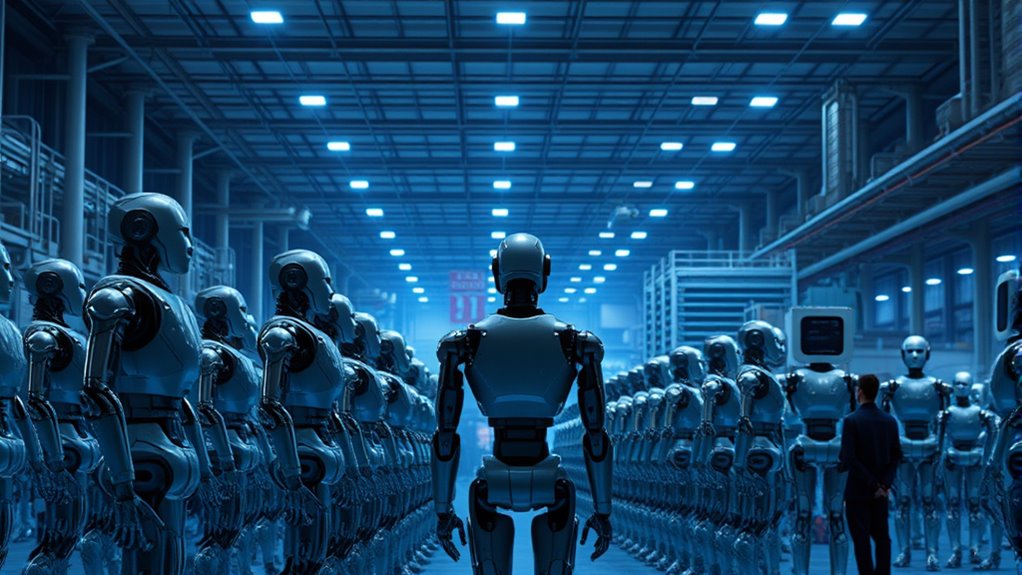
When robotic capital becomes concentrated, you may notice wealth and market power shifting toward a few large players, increasing economic inequality. This can make it harder for smaller firms and workers to compete, widening the income gap. Addressing these effects requires careful regulation and policies to distribute benefits more equitably. Additionally, as the demand for electric home furnishings like heated mattress pads increases, there may be shifts in manufacturing and energy consumption patterns that impact the broader economy. Regular use of glycolic acid products can improve skin tone and clarity, which parallels how targeted policies can help distribute economic benefits more evenly. Recognizing signs of spoiled lemon juice can be important for consumer safety, much like recognizing early signs of economic disparity can help in crafting effective interventions. As cyber threats continue to evolve, the integration of AI security technologies can play a vital role in safeguarding these economic shifts and maintaining stability. Incorporating practices like meditation can also foster resilience among workers facing economic uncertainty, promoting mental well-being amidst rapid technological change.
Capital Concentration Effects
Automation tends to concentrate wealth and power among those who own and control advanced capital assets. This intensifies existing inequalities by funneling more income to large capital owners, leaving smaller players behind. The ownership of automation technologies becomes a key factor in wealth distribution, as only those with substantial capital investments can benefit from automation’s gains. High capital requirements reinforce this advantage, making it difficult for smaller firms to compete. Additionally, global investment patterns favor multinationals and developed countries, further widening the gap. This concentration impacts market dynamics by shifting supply and demand, often to the benefit of the top-tier capital holders. Overall, automation accelerates the centralization of wealth, creating a more skewed economic landscape. Furthermore, the increasing reliance on robotic and AI capital assets emphasizes the importance of technology ownership as a determinant of economic power. As automation continues to evolve, the ownership structures of these technologies will play an increasingly pivotal role in shaping economic hierarchies and access to growth opportunities. Recognizing the role of material resources in supporting automation infrastructure highlights how resource control can further exacerbate wealth disparities.
Income Inequality Risks
The concentration of capital through automation magnifies income inequality by shifting wealth toward those who own and control robotic technologies. As automation displaces lower-skilled workers, wages stagnate for many in blue-collar and clerical jobs, widening the income gap. About half of Americans believe AI will deepen societal polarization, and data shows the top 1% benefit disproportionately from robotics, increasing their income share. Technology favors high-skilled workers, leaving low-education workers behind. Automation accelerates economic polarization by automating tasks that once provided stable employment for lower-income groups. Meanwhile, capital owners, especially at the top, profit from increased productivity and exports, further concentrating wealth. This growing disparity threatens social cohesion and highlights the urgent need for policies to address the risks of robotic-driven income inequality.
Workforce Dynamics and Automation Challenges
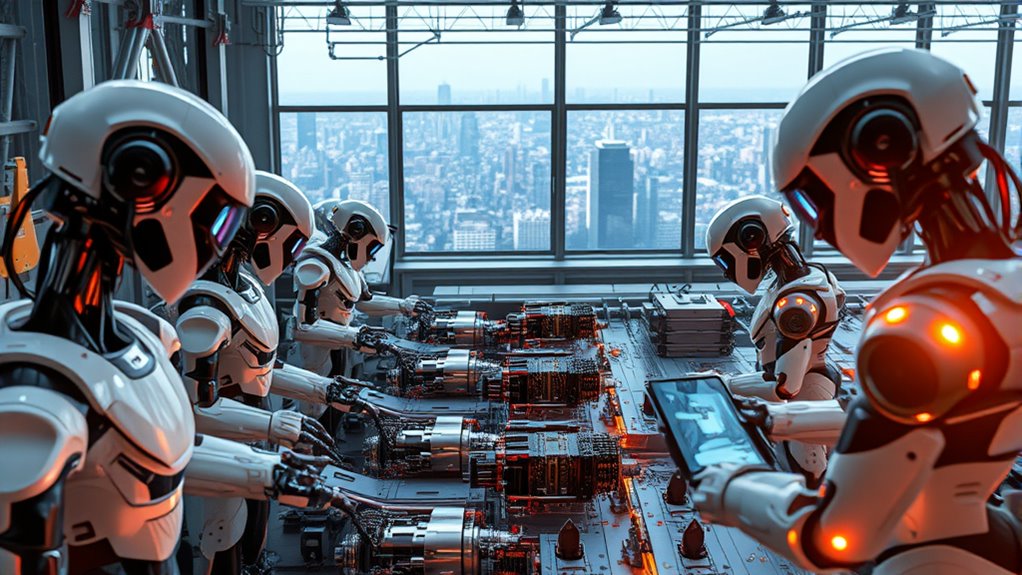
As organizations increasingly adopt intelligent automation, they face the challenge of balancing technological advancements with human talent. You’ll need to integrate automation smoothly while preserving essential human skills like creativity, problem-solving, and emotional intelligence. This shift impacts workforce dynamics, requiring strategies for effective talent development. Automation is already automating 94% of repetitive tasks, boosting job satisfaction for IT workers and enhancing cross-functional teamwork. You must focus on building a workforce that leverages automation’s benefits without losing the human touch. Consider these points:
- Prioritize developing skills that complement automation, such as emotional intelligence and creativity
- Manage talent acquisition challenges by fostering roles that adapt to technological changes
- Balance automation deployment with human oversight to sustain innovation and relationships
Successfully steering these challenges is key to future-proofing your organization.
Technological Advances Driving Ownership Models
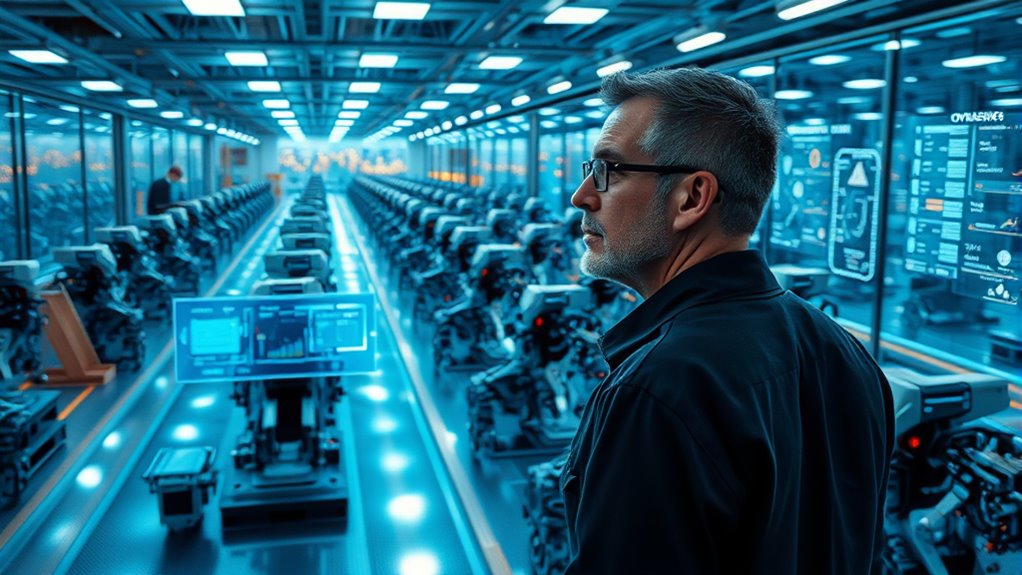
Technological advances are fundamentally reshaping ownership models in robotics by enabling more adaptable, efficient, and integrated systems. AI-driven innovations, like generative and analytical AI, allow robots to learn from simulations and analyze sensor data, boosting performance without extensive reprogramming. Robotics simulation tools improve training and deployment, making robots more versatile across industries. The rise of humanoid, industrial, and service robots reflects these technological leaps, with increased robot density and market value. Mobile manipulation and collaborative robots enhance human-robot interaction, broadening application scopes. These developments attract significant investments, driving growth and transforming capital ownership structures. As automation levels rise and AI integration deepens, ownership models evolve toward more flexible, data-driven arrangements, aligning control and value with technological capacities.
Investment Trends and Future Market Opportunities
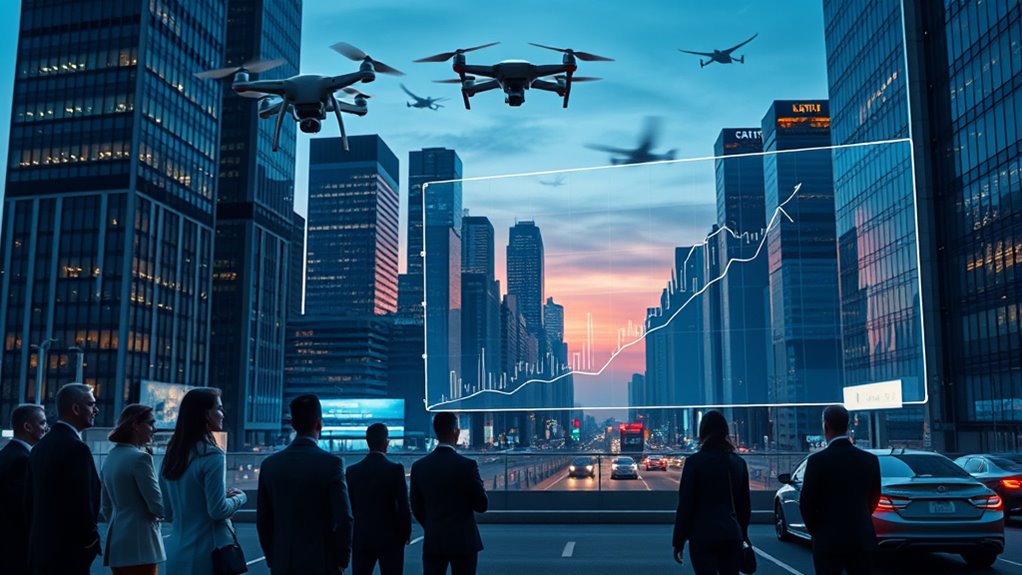
Investment trends in automated economies are shifting rapidly, with governments and private investors prioritizing infrastructure upgrades that support digital connectivity, energy efficiency, and transportation modernization. You’ll see increased funding in renewables, energy tech, and expanding 5G networks, data centers, and AI hubs essential for automation. Transportation investments focus on rail, EV charging, and logistics hubs to enable autonomous mobility and supply chains.
Consider these future market opportunities:
- Growth in AI-related semiconductors and enterprise AI solutions for automation.
- Blockchain-powered tokenization of assets, making ownership of robotics equipment more accessible.
- Resilient infrastructure investments driven by trade policy shifts and localization efforts.
These trends signal a moving landscape, ripe for strategic investment in automation-driven sectors.
Frequently Asked Questions
How Will Robotic Ownership Affect Income Inequality in the Future?
You might wonder how robotic ownership impacts income inequality. As robots and automation become more concentrated among a few large corporations and investors, wealth shifts upward, increasing disparities. When fewer owners control the technology, they capture most benefits, leaving workers with less. This concentration widens the income gap, especially as automation replaces low-skilled jobs. Unless policies or redistributive measures are implemented, automation’s benefits could deepen economic inequality.
What Role Do Households Play in Owning and Controlling Personal Robots?
You play a key role in owning and controlling personal robots, especially as adoption grows worldwide. By purchasing robots for chores, productivity, or companionship, you influence how these devices integrate into daily life. Your choices drive market demand and technological advancements, shaping the future of automation. As a user, you also control how robots support your household needs, making you an active participant in the evolving landscape of domestic automation.
How Are Legal and Ethical Issues Impacting Robot Ownership Rights?
They say, “Where there’s a will, there’s a way,” but legal and ethical issues complicate robot ownership rights. You see, current laws don’t recognize AI as owners or creators, raising questions about liability and intellectual property. Ethical concerns about AI sentience and rights challenge traditional ideas of ownership. As AI advances, these issues will shape future regulations, pushing you to reflect on how society balances innovation with morality in a rapidly changing landscape.
Who Benefits Most From the Economic Gains of Automation?
You’ll find that the biggest beneficiaries of automation’s economic gains are capital owners and large corporations. They profit from increased productivity and reduced costs, while workers often face job displacement and wage stagnation. Developed countries and wealthy investors enjoy the most, as they can afford automation at scale. Meanwhile, lower-income regions risk being left behind, widening global inequality and concentrating wealth among those who control the technology and infrastructure.
How Might Ownership Structures Evolve With Advances in AI and Robotics?
You might see ownership structures shift as AI and robotics advance. Large corporations and investors could consolidate control, but new models like Robots-as-a-Service and digital platforms promote shared or decentralized ownership. Governments and communities may push for public or cooperative ownership to guarantee broader benefits. Additionally, financial innovations like tokenization could fractionalize ownership, making robotic assets more accessible and transforming how you participate in and profit from automation.
Conclusion
As you consider the future, remember that over 80% of industrial robots are owned by a handful of large corporations, highlighting growing capital concentration. This shift affects jobs, innovation, and wealth distribution. Embracing these changes means staying informed and adaptable. The rise of personal robots also signals new ownership opportunities. By understanding these trends, you can better navigate the evolving landscape of automation and capitalize on upcoming market shifts.



